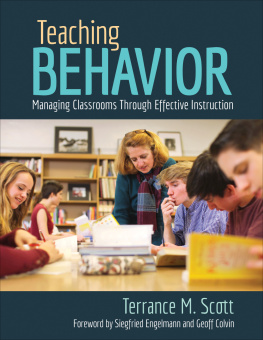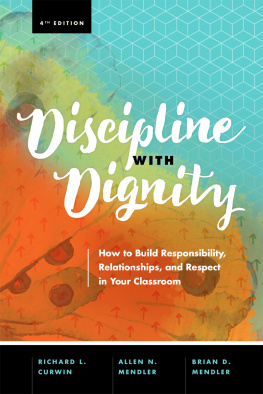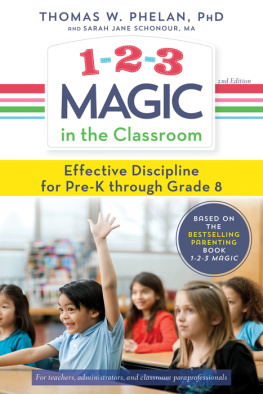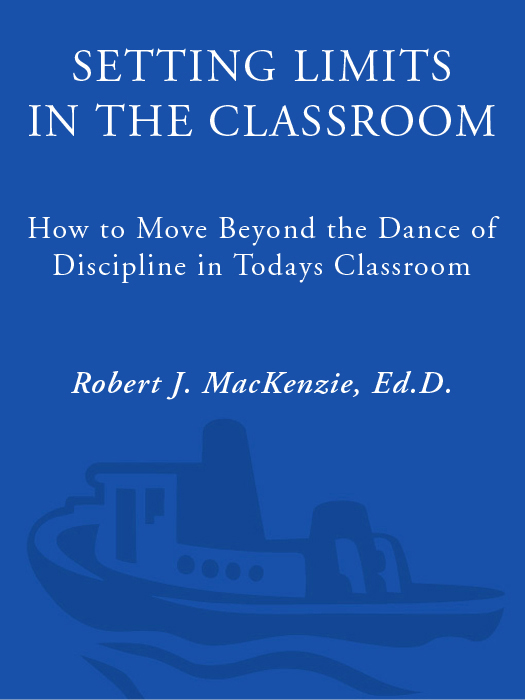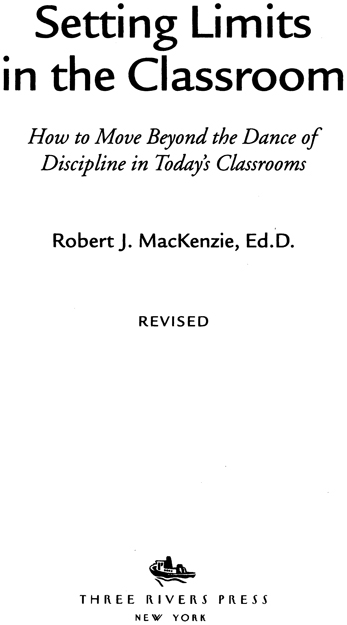ACKNOWLEDGMENTS

T HIS BOOK BEGAN eighteen years ago as a workshop for teachers. My sincere appreciation goes to all who participated in these workshops over the years. Your experiences, and your willingness to share them, helped refine and improve the methods in this book.
Special thanks also go to those who have supported my workshops in major ways and to those who assisted with the writing of this book.
To Bob Trigg, former superintendent of the Elk Grove Unified School District, for funding and supporting my workshops for teachers for the first ten years.
To Dave Gordon, current superintendent of the Elk Grove Unified School District, for funding and supporting my TRIC (Training Responsible, Independent Children) workshops for teachers during the last eight years.
To the many principals of the Elk Grove Unified School District who have supported my efforts toward staff development.
To the many effective teachers Ive had the privilege to observe and work with over the years. You are the real masters of effective classroom management.
To Jamie Miller, Marjorie Lery, and all the other good folks at Prima Publishing for believing in my project.
To Dr. Jonathon Sandoval, professor of education, University of California, Davis, for your technical expertise with portions of the book.
To Jean Seay for your assistance with the many charts and diagrams.
To Lisa Stanzione, special education teacher with the Elk Grove Unified School District, for assisting with my workshops and providing helpful feedback.
To Judy Wyluda, program director; Tad Schmitt, executive director; and all the good folks at Staff Development Resources and the California Elementary Education Association for promoting my workshops on a national level.
To all the parents and children Ive seen over the years in my counseling work. Your successes have strengthened my beliefs in the process weve shared together.
INTRODUCTION

I N MANY SCHOOLS , the lessons of classroom management have become part of a hidden curriculum. Theyre not discussed at curriculum meetings. They dont show up anywhere in the teachers daily lesson plan, yet they require as much, if not more, of the teachers time and energy than any other academic subject. In fact, teachers cant teach their academic subjects effectively until they can establish an effective environment for learning.
Classroom management is simply too important to be neglected or handled ineffectively. The cost to teaching and learning, to our schools, and to our culture is too great. My bias is clear: Guidance and discipline should be taught like any other subject with a sound curriculum, proven state-of-the-art methods, and consistency across grade levels and throughout the school.
As a family guidance counselor and parent/teacher trainer for a large northern California school district, I see nearly two hundred students each year who are not stopping at the signals they confront in the classroom. They dont respect rules or authority, and many lack the basic social skills to be successful students. Some are suspected of having emotional or learning problems, and a few do, but the vast majority is not suffering from any problem at all. They are simply exercising their willpower in the hope they can wear adults down and do what they want. Often, theyre successful.
By the time these students reach my office, their teachers have tried a variety of techniques to stop the misbehavior. Theyve tried lecturing, threatening, reasoning, explaining, bribing, cajoling, writing names on the board, taking away recesses, and making students write apology letters. Theyve tried making them stand in the corner, sending them to the office, issuing citations, sending home daily behavior reports, and asking parents to spend a day in the classroomall without success.
Their methods range from extreme permissiveness to harsh punishment and all points in-between, but most of these teachers share at least one thing in common: Theyre having trouble setting limits in their classrooms. Theyre doing the best they can with the tools they have, but the tools arent working, and they dont know what else to do. Teachers need effective methods.
Setting Limits in the Classroom provides you with the guidance curriculum and effective methods you need to stop misbehavior and teach your rules in the clearest and most understandable way. You can say good-bye to all the ineffective methods that wear you down and get you nowhere. No more reasoning, explaining, lecturing, or threats. No more drawn-out consequences or exhaustive attempts at persuasion. And you can say good-bye to all the power struggles, too. Your students will know what you mean when you set clear, firm limits and support your words with effective actions. This book will show you how to do that. The methods should be a welcome alternative to the ineffective extremes of punishment and permissiveness.
In the chapters that follow, youll learn an approach to child guidance that is clear, systematic, and developmentally appropriate for your students, one that has been tested and used successfully by thousands of teachers and parents. The methods work, and you can use them with children of all ages, from preschoolers to secondary students.
The first five chapters of this book will attempt to do what most books on guidance and discipline leave outthat is, to help you recognize the things youre doing that arent working for you. Without this awareness, it will be difficult, if not impossible, to avoid repeating your old mistakes, because most of these mistakes are made unconsciously. Youll discover your to limit setting, how children really learn your rules, the types of limits youre using, and the type of classroom dance you might be doing to get your students to cooperate.
With an understanding of what hasnt worked for you, youll be ready to learn new skills. Chapters 6 through 13 form the core of the skills-training program. In these chapters, youll learn how to give clear messages about your rules, stop power struggles before they begin, support your rules with instructive consequences, manage extreme behavior, and how to use the office for back-up support.
In chapters 14 and 15, youll learn effective motivational strategies for inspiring cooperation, building positive relationships, and increasing on-task time. , youll learn how to solve problems with homework.
The final chapter is intended to provide relief for administrators and help them improve the efficiency and effectiveness of their schools guidance program. Whether your program requires a tune-up or a major overhaul, this chapter will help you put the parts back together so they work in an efficient and cost-effective manner.


